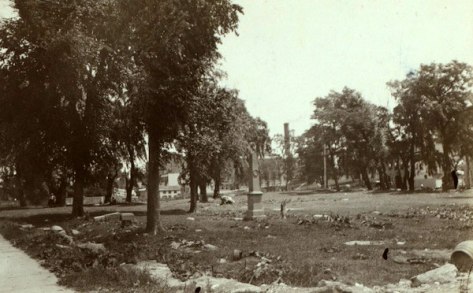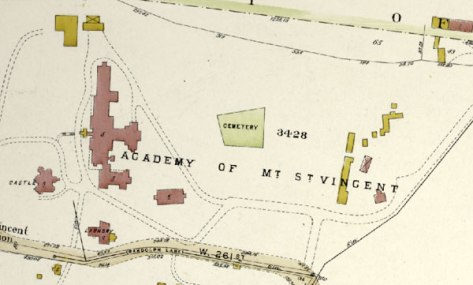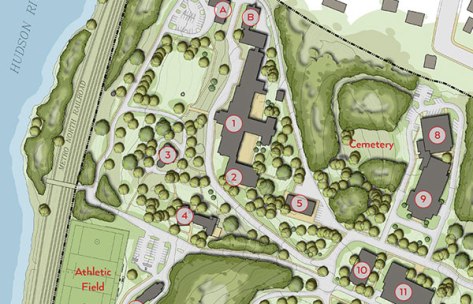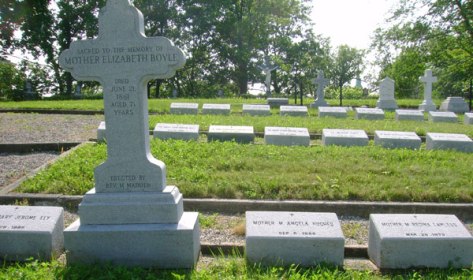
An 1870 newspaper article describes Memorial Day observances held in Bensonia Cemetery:
Yesterday morning the members of Post Oliver A. Tilden, No. 96 of Morrisania, assembled at 6 o’clock, and marched to Bensonia Cemetery. Following the procession, with a wagon filled with flowers was the colored body servant of Capt. Tilden, who was during all the campaigns of the war in the field. The Post was under the command of Wesley Farrington. On their arrival at the cemetery, the men, numbering about fifty, formed a hollow square about the grave of Capt. Tilden with a solitary woman mourner in the inclosure. Commander Farrington then made a short address to his comrades and those gathered there, when he deposited on the monument a handsome wreath of white flowers. Chaplain Geo. G. Chase then made a short, appropriate prayer, after which he and the rest of the members of the Post each laid their floral gift on the grave. They then proceeded to New-York to take part in the parade and floral decorations at Cypress Hill Cemetery. (New-York Tribune, May 31, 1870)
Bensonia Cemetery was established in 1853 as a community burial ground for the Town of Morrisania, which was then a part of Westchester County. In 1874 Morrisania was annexed by New York City and today comprises a portion of the South Bronx. Bensonia Cemetery was located along St. Ann’s Avenue, extending from Rae Street to Carr Street. Developed by James L. Parshall, one of the original settlers of Morrisania, the cemetery was a picturesque spot, densely shaded by elms, poplars, and evergreens.
Oliver Tilden, who was born and raised in Morrisania and enlisted in the Union Army at the outbreak of the Civil War, was buried at Bensonia after he was killed in combat near Chantilly, Virginia, in September 1862. Tilden was the first soldier from this neighborhood to give his life for the Union during the Civil War. His remains were transferred to Woodlawn Cemetery in 1878.
It is unknown how many other individuals were interred at Bensonia before it was closed to burials in 1868. About a third of the cemetery was taken in 1870 when St. Ann’s Avenue extended through the site and a large number of disinterments were made at that time. More burials were disturbed in 1893, when German Place was laid out along the west side of the graveyard. By the turn of the century, only about two acres remained of the original Bensonia Cemetery, and the abandoned property, with just a few gravestones still standing, had become a dumping ground for neighborhood refuse. In 1908 Bensonia was taken by the city for public use and the graves were transferred to Woodlawn Cemetery. Public School 38 (now called the South Bronx Educational Complex) was built on the site in 1921.



Update: Construction workers uncovered remains from Bensonia Cemetery when digging at South Bronx Educational Complex in Feb. 2020
Sources: “Decoration Day,” New-York Tribune, May 31, 1870, p. 1; “Suited for a Park Park Site: Bensonia Cemetery Now a Dirty Waste,” New-York Tribune, April 8, 1900, p. A4; “Do You Remember,” by Bill Twomey, Bronx Times, Nov. 25, 2009; Captain Oliver Triangle, NYC Parks & Recreation ; Annual Financial and Statistical Report of the Board of Education of the City of New York 1922 p. 147; Beer’s 1867 Plans of Westchester, West Farms, Morrisania, Westchester Co. and Part of New York County; Robinson’s 1885 Atlas of the City of New York Pl 34; NYCityMap; Construction Workers in Mott Haven Dig Up Human Remains Believed to be Over 100 Years Old (News12, Feb 5, 2020)




